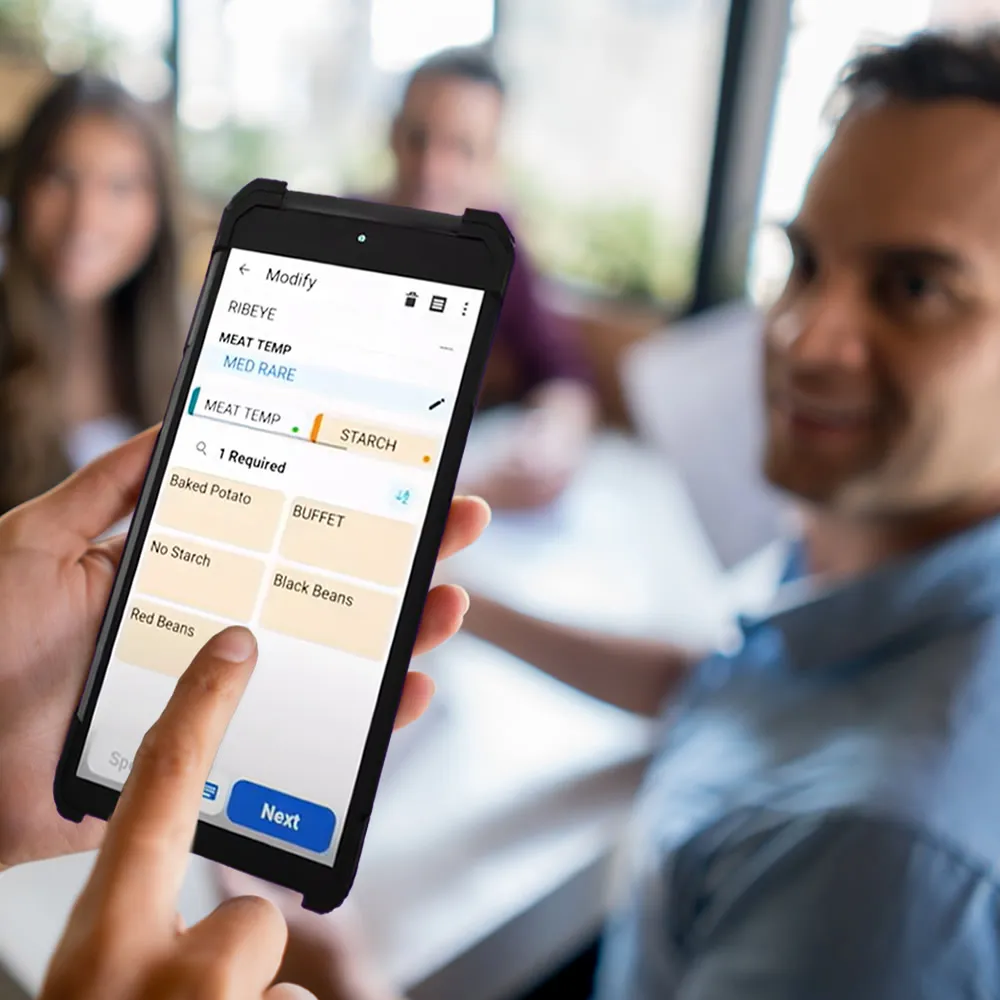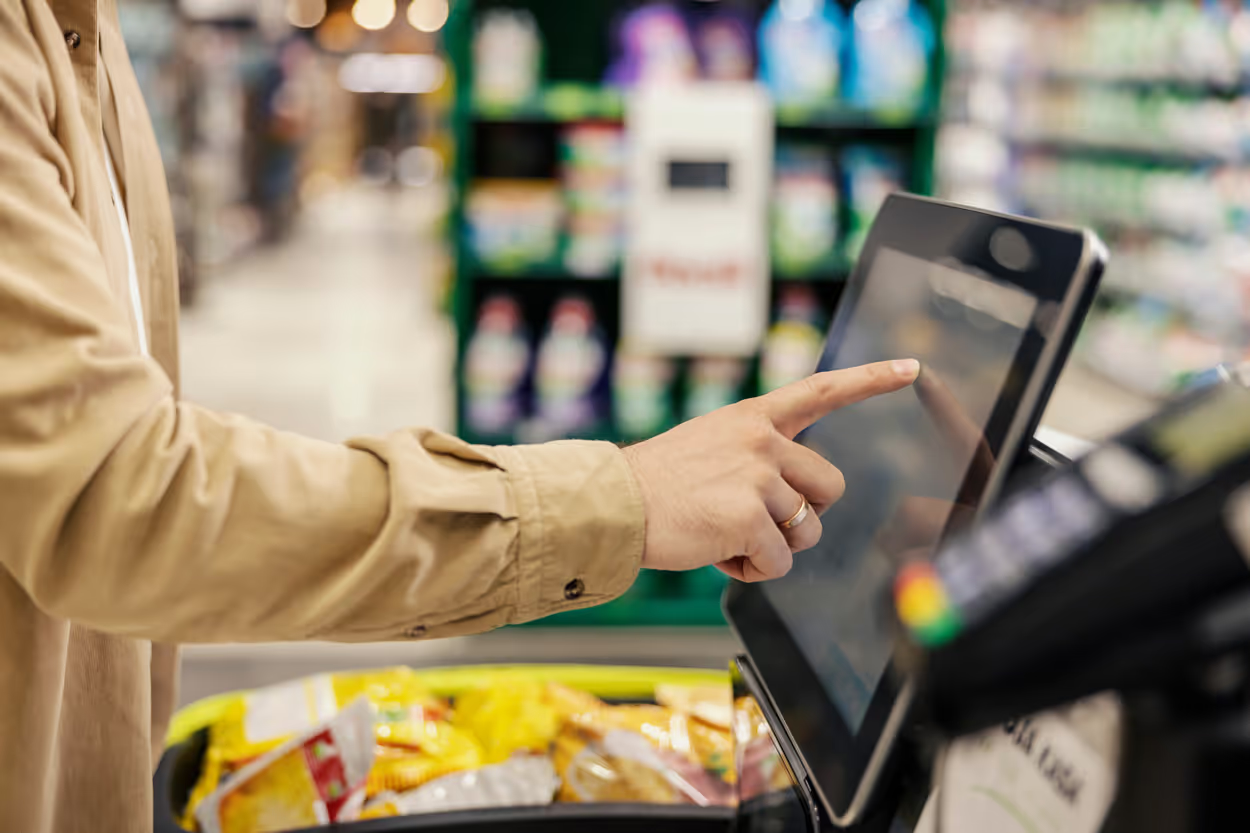Why spend the time and resources to convert your self-checkout experience into touchless now? This is just a short-term environment, right? Not so fast. Many retail owners and operators believed the health and safety measures put into place because of the pandemic would be temporary—but the changes aren’t going anywhere anytime soon. And neither are today’s new shopper preferences. Indeed, 87 percent of shoppers say they’d prefer to shop in stores with touchless or robust self-checkout options. So now is the time to take bigger contactless steps, like making your self-checkout totally touchless.
How to go completely touchless with self-checkout
To meet increasing consumer demands for totally touchless shopping, grocery stores are quickly adopting technologies that have been in the works for years. But, there are also some simple ways to make touchless shopping possible for customers—using the self-checkouts you already have. To reduce contact with self-checkout screens and increase efficiency, you can:
- Use signage and train your associates to encourage shoppers to scan their first item to start the transaction rather than touching the “start” button
- Recommend customers use cash they can insert into your point-of-sale (POS) system instead of using a pin pad or touching a screen to pay
- Change your self-checkout software so payment begins when your customers insert their cards versus touching the screen to get it started
- Enable your POS to accept mobile payments and your customers’ digital wallets for contactless payments like Apple Pay, Google Pay and WeChat Pay
- Encourage self-checkout attendants to use barcodes when they need to assist shoppers to avoid touching the screens (and, if that isn’t possible, provide them with gloves to wear if they need to touch the screen)
- Redesign your store layout to support social distancing measures, including spacing out displays as much as possible and stocking shelves when business is slow (or before opening and after you close)
Technologies that take touchless self-checkout to the next level
Saying yes to biometric technology
Authentication from embedded fingerprints and eye recognition has been on the rise for years, particularly in countries like India and China. Now, during the pandemic, worldwide adoption is accelerating.
In 2018, for example, Visa launched a payment card that’s fingerprint enabled. So, while there is a chip that customers can use if they prefer, the customer’s fingerprints are also stored on the card. During a transaction, the customer puts their finger on the card’s sensor to activate the card and pay for the transaction. There’s no need to insert the card or enter any numbers on a pin pad, provide signatures or any other “touchy” way to complete payment.
And, Visa’s fingerprint enabled cards can be accepted by any POS system that supports EMV cards and mobile payments. Not only do they make totally touchless payments at self-checkout possible, they offer much more security and they’re self-charging.
Handheld scanners and phones scanning bar codes
In the not-so-distant future, consumers may scoff at any kind of checkout, whether assisted or self-checkout. Putting items into a cart, standing in line (what?), unloading and scanning each item in the self-checkout POS, placing them into bags and then putting the bagged items back into the cart will seem like a lot of steps compared to what’s on the way...or even here already.
Either through sanitized hand-held scanners the store provides or apps downloaded on customers’ phones, shoppers can scan as they shop, replacing all the checkout steps they’ve had to take in the past.
For example, Giant Food stores launched an app that, once downloaded, makes totally touchless self-checkout easy, convenient and budget-control friendly. Using their phones, customers scan bar codes of each item and the app keeps a running total of how much they’re spending as they go. Once they reach the self-checkout area, they’re directed to a POS system that looks more like a screen embedded into a wall and all they have to do is walk up to it and wait for a green light and then walk out of the store. Watch a short video to see Giant Food’s Scan It! shopping experience in action.
The QR code revolution
Invented in 1994, QR codes have had an interesting history. While years ago they seemed outdated, they’ve made a big comeback. In China, they’re fueling a nearly cashless society where consumers’ phones have truly become their digital wallet (no need for the leather billfold). QR codes are everywhere and the use of cash is becoming more and more rare in China.
And, around the world, QR codes are being used in countless ways to support businesses and give their customers easy contactless services during the pandemic. The information that’s easily scanned via smartphones (most are enabled with QR code readers) is allowing restaurants to digitally send menus to customers and giving retailers like Ralph Lauren the ability to better manage its supply chain.
It’s also helping the global government response to COVID-19—China, for example, developed an app that uses QR codes to allow people in 200 Chinese cities to see if they’ve come close to anyone who has tested positive for COVID-19.
Some grocery stores are using QR codes for touchless self-checkout experiences, too. At Walmart, customers can scan a QR code at self-checkout to make their payments. They’re also placing QR codes on printed receipts so Walmart customers can price-check the items they paid for. And if it turns out the same items are available for less at another location, they’ll give them back the difference—customers can choose to build up their returned money and use it to make future purchases.
Technology from NCR is helping, too
One way that NCR can help retailers achieve totally touchless self-checkout is by using NCR FastLane Remote Attendant Program (otherwise known as RAP) technology to enable attendant remote approval of self-checkout interventions, where applicable. NCR NextGen Mobile RAP:
- Is an in-store service that provides employees the ability to monitor and respond to multiple self-checkout lanes on a handheld mobile device
- Ensures a fast, frictionless checkout experience for your consumers and an effective intervention process for your employees.
We’ve come a long and touchless way this year
On March 11, 2020 the World Health Organization officially declared COVID-19 a global pandemic and terms like “social distancing” and “contactless” became household terms nearly overnight. But, initially these were seen as temporary measures to stop the spread of COVID-19.
It’s clear now that, in many ways, the world won’t be going back to the old ways and that certainly includes self-checkout systems. And that’s because retailers have learned more about the benefits of contactless services. They’re not just safe; they’re more convenient, faster and provide better customer service. So, with the tips and the technology to get there, giving your customers totally touchless self-checkout will be giving them what they want.




